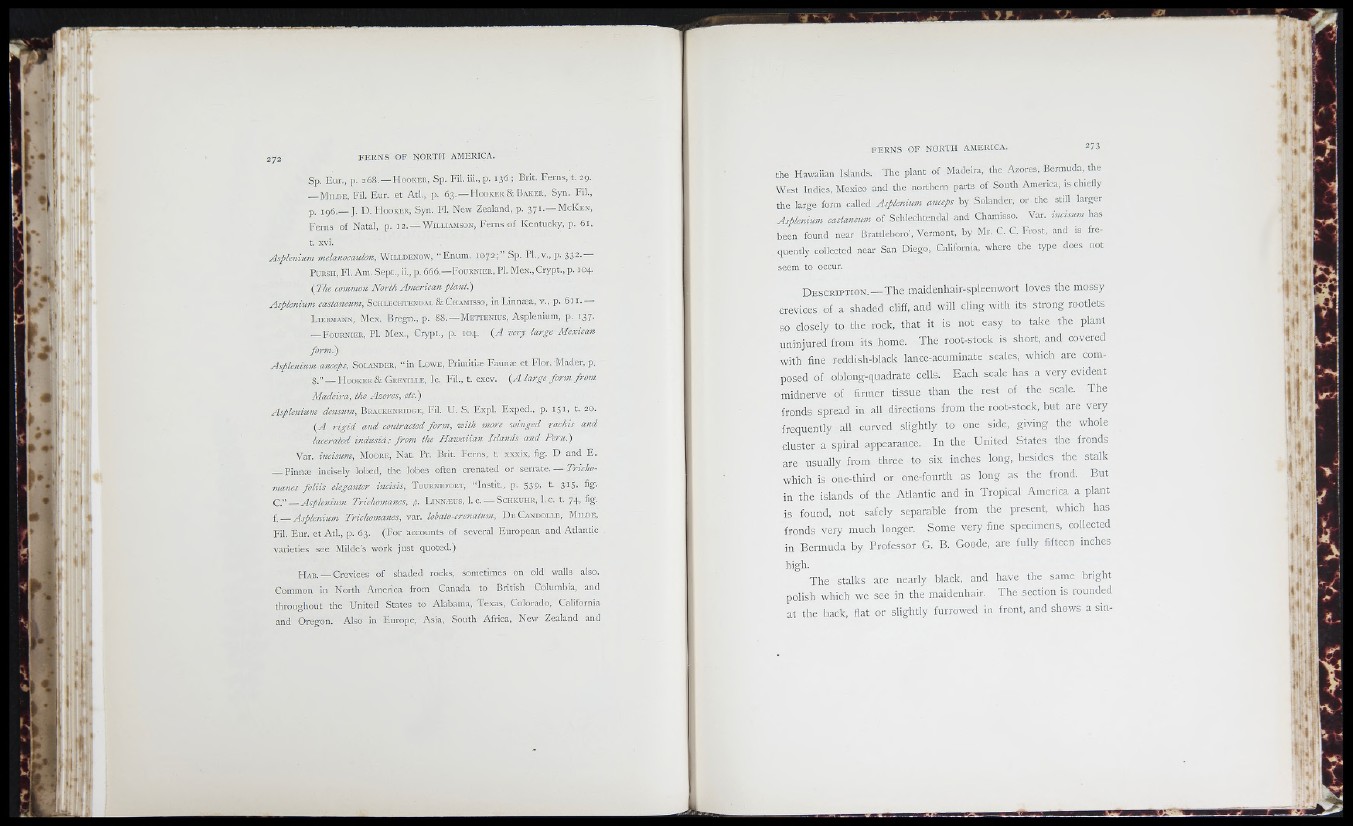
I * ,
• i h
it B
r
r*.
; j i f .
. I
..•»I
* .
i f t * .
I' i
l ' É *
• I :',
A
Si*
m
■’ ■ fr ;
Ï :■
¡ 1 . 1 .
m K
Sp. Eur., p. 2 6 8 . — H o o k e r , Sp. Fil. iii., p. 1 3 6 ; Brit. Ferns, t. 29.
— M il d e , Fil. Eur. et A t l, p. 63. — H o o k e r& B a k e r , Syn. Fil.,
p, 196.— J. Ü. H o o k e r , Syn. FI. New Zealand, p. 3 7 1 .— M cK e n ,
Ferns of Natal, p. 1 2 .— W il l iam so n , Ferns of Kentucky, p. 61,
Asplenium mclanocatUon, W i l l d e n o w , “ Enum. 1072; Sp. Pl.,v., p. 332.
P u r s h , FI. Am. Sept., Ü., p. 666.— F o u r n i e r , Pi. Mex., Crypt., p. 104.
( The coimnon North American p la n t)
Asplenium castancum, S c h l e c h t e n d a l & C h a m i s s o , in Linnæa, v . , p. 6 1 1 . —
L i e b m a n n , Mex. Bregn., p. 88.— M e t t e n iu s , Asplenium, p. 137-
— F o u r n i e r , PI. Mex., Crypt., p. 104. {A very large Mexican
fo rm )
Asplenium anceps, S o l a n d e r , “ in L o w e , Primitiæ Faunæ et Flor. Mader, p.
8 . ” _ H o o k e r & G r e v i l l e , I c . Fil., t. c x c v . {A large fo rm from
Madeira, ihe Azores, etc)
Asplenium densum, B r a c k e n r id g e , Fil. U. S. Expl. Exped., p. 15 1 , t. 20.
{A r ig id and contracted form, with more winged rachis and
lacerated indusia; from the Hawaiian Islands and P e ru )
Var. incisum, M o o r e , Nat. Pr. Brit. Ferns, t. xxxix, fig. D and E .
Pinnæ incisely lobed, the lobes often crenated or serrate. — Trickomanes
fo liis eleganter incisis, T o u r n e f o r t , “ Instit., p. 539- t- 3 i 5 - %■
C.” Asplenium Trichomanes, y L in n æ u s , I.e. — S c h k u h r , I.e. t. 74, fig.
f . Asplenium Trichomanes, v a r . lobato-crenatum, D e C a n d o l l e , M i l d e ,
Fil. Eur. et A t l, p. 63. (For accounts of several European and Atlantic
varieties see Milde’s work just quoted.)
Crevices of shaded rocks, sometimes on old walls also.
Common in North America from Canada to British Columbia, and
throughout the United States to Alabama, Texas, Colorado, California
and Oregon. Also in Europe, Asia, South Africa, New Zealand and
r
the Hawaiian Islands. The plant of Madeira, the Azores, Bermuda, the
West Indies, Mexico and the northern parts of South America, is chielly
the large form called Asplenium anceps by Solander, or the still larger
Asplenium castancum of Schlechtendal and Chamisso. Var. incisum has
been found near Brattleboro', Vermont, by Mr. C. C. Frost, and is frequently
collected near San Diego, California, where the type does not
seem to occur.
D e s c r i p t i o n . — The maidenhair-spleenwort loves the mossy
crevices of a shaded cliff, and will cling with its strong rootlets
so closely to the rock, that it is not easy to take the plant
uninjured from its home. The root-stock is short, and covered
with fine reddish-black lance-acuminate scales, which are composed
of oblong-quadrate cells. Each scale has a very evident
midnerve of firmer tissue than the rest of the scale. The
fronds spread in all directions from the root-stock, but are very
frequently all curved slightly to one side, giving the whole
duster a spiral appearance. In the United States the fronds
are usually from three to six inches long, besides the stalk
which is one-third or one-fourth as long as the frond. But
in the islands of the Atlantic and in Tropical America a plant
is found, not safely separable from the present, which has
fronds very much longer. Some very fine specimens, collected
in Bermuda by Professor G. B. Goode, are fully fifteen inches
high.
The stalks are nearly black, and have the same bright
polish which we see in the maidenhair. The section is rounded
at the back, flat or slightly furrowed in front, and shows a smi
A
il ■
I
*i
'
i
i ,
• 4 I
' l i
I f
I